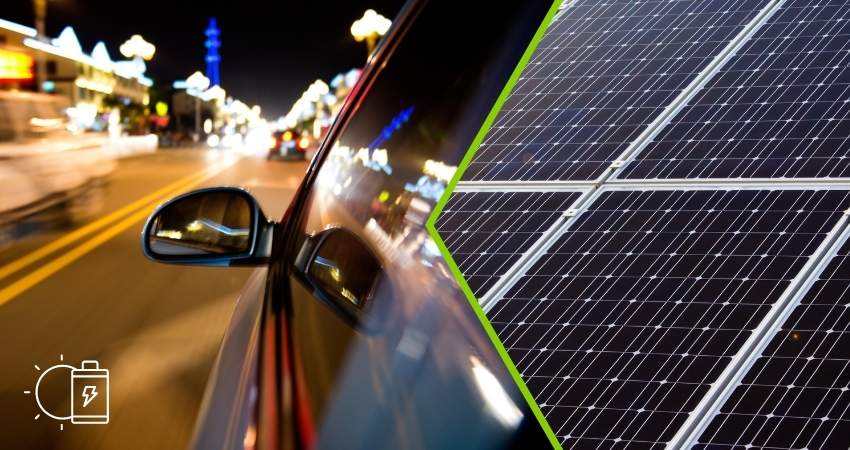Solar cars are a type of electric car which are eco-friendly and work without leaving hazardous gasses in the environment. These cars work by storing sunlight in photovoltaic cells during the daytime and using the stored energy to power the car’s motors. So, How do Solar-Powered Cars Work at Night?
Solar power cars have batteries and solar panels. These panels convert the sunlight into electrical energy in the daytime and store it in batteries. Then, at night-time, the car utilizes the stored energy. There are many other ways cars work at night.
We will discuss some of them below in detail.
How Does a Solar Powered Car Work?
A solar car is like an electric car that works without fuel. The primary energy needs of a solar vehicle depend on batteries and solar panels. There are multiple batteries available in the market, but solar cars use special lithium batteries. Because these batteries have the potential for charging efficiency and are lightweight, they can fit in the bottom part of cars. In comparison, solar panels are on the roof of vehicles. Solar cells are non-polluting and silent. They convert 10 to 15% of solar energy and store it in batteries. These batteries transfer this power to the motor and work as fuel for the whole electric vehicle. This way, the car runs on the road.
How Can Solar Power Cars Be Used at Night?
Solar cars use sunlight to convert them into electricity. How can solar power cars be used during the nighttime? Modern technology can also utilize at night. Solar energy doesn’t mean you can only use it during the daytime.
What do you need to fulfill this task? It’s nothing but lithium batteries you have to store and connect with solar panels. Solar cars store the solar energy in their batteries and use them in the absence of sunlight.
Ways to Power Solar Cars at Night
Now solar cars are not limited to the daytime power supply. There are multiple ways you can produce energy to run your car at night time— I will discuss the most common methods below.
Charging Solar Batteries
Solar cars use batteries, which need charging to work at night, whether you provide them through solar panels or external charging ports. The most advanced example of battery-charged cars is Tesla which uses cylindrical batteries.
Electric Vehicle Charger
Another way of charging electric cars at home is by installing EV chargers. It costs around $300 to $1200 according to the charger capacity. There are two EV chargers, Level 1 with 120v and Level 2 with 240v. However, most EV drivers prefer installing an electric charger at home to save time and cost and avail charging facility at night.
Note: To Store Solar Energy at Commercial Level
Installing a solar thermal power plant in an area is a considerable investment but beneficial for all. The plant contains a mixture of salts such as sodium and potassium nitrate that store sunlight as heat energy. Molten salts store heat energy and power the solar system at night.
Use a heat exchanger to get the molten salts close to the water to produce steam. Thus, the turbines use hot steam to generate electricity. Not only cars, but you can run your entire house with this mega plant whether you use it during the day or at night.
Andasol 1 or Solana are examples.
Challenges Powering Solar Cars at Night
Running a solar-powered car is advantageous, but on the other hand, there are some challenges you may face, as mentioned below.
Not Enough Power
Electric cars work best in the daytime, but their solar panels and batteries are not sufficient to produce a higher amount of energy that may run at night time smoothly.
Cloudy Countries and Solar Cars
Countries with minimum sunlight can entertain these cars in the evening until sunset. After that, it will be useless because low sunlight solar panels cannot charge the battery.
Time Consuming
Electric cars take much time to charge along with limited charging station options.
Shorter Range
You might face issues covering longer distances at night depending on the battery size and charging efficiency.
Solar Car Mileage
Solar panel cars use electric motors by replacing combustion engines. These cars are light and cannot bear a heavy load. Therefore, they are only capable of carrying one person. Thus, they demonstrate peak speed running. These vehicles are flat and wide, creating less air resistance, and can run at a maximum speed of up to 60 mph. So, solar cars for racing range from 40 to 60 mph, i.e., 64.6 km/h to 96.6 km/h. This speed is not enough for a patrol highway car or everyday use.
Twist came in 2010 when the University of Michigan Solar Car team race car won the prestigious American Scholar Challenge. This car “Infinium” reached a record-breaking speed of 105 mph (169 km/h). It was a grueling six-day race of 1100 miles (1770 km). It was not a Spartan straight track race, but these were intersections with stop lights.
As the technology improves, engineers are also working on the design of these solar cars. This race is not a test of drivers’ driving but technology. Now they are trying to improve the mileage as well. A recent example of these cars is the Tesla Roadster, which has a top speed of 125 mph (201 km/h).
Conclusion
Many people are curious about how solar-powered cars work at night. They require some batteries in which photovoltaic cells on the solar panel store sunlight during the day, and the car uses this power at night. You don’t need any fuel to run it as it relies 100% on solar panels and batteries. Solar vehicles may reach a maximum distance of 150 km with being a new technology, and over time, we can expect to have much better loadbearing capacities and longer ranges.



Thanks for your blog, nice to read. Do not stop.